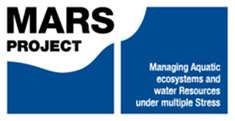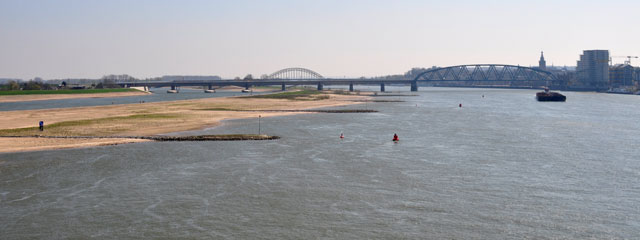Flood protection
More than 200 major floods have been reported in Europe since 2000 (EEA 2012a). Global warming is projected to increase the occurrence and frequency of flood events in large parts of Europe, and flood protection is, and will remain, a significant driver of human pressures on river ecosystems.
Many European rivers and waterways have been physically altered in order to manage the impact of high water flows resulting from high discharges or ice jamming and minimise flood damage. For centuries, 'hard' infrastructure measures such as levees, bank enforcements and dikes, water storage reservoirs, and the straightening of rivers and pumping canals have been the primary form of flood defence in Europe. Such engineering alters the dynamics of environmental flows through the river catchment and ecosystem, decreases habitat diversity, and decouples the river channel from its wider floodplain, potentially leading to significant negative impacts on ecological status and ecosystem service provision.
Such technical flood management measures tend to focus only on the site of flood occurrences: i.e. the floodplain itself (dikes), or where the river breaks its banks (bank enforcements). The EU is now promoting a river-basin approach to flood protection, whereby the problem of flooding is tackled across the whole river catchment, rather than just the end-point of the problem. This can include reforestation of moors and uplands, the restoration of wetlands, and increasing the resilience of human settlements and activities through better advance warning and emergency response systems. The strategy can be summarized retain, store, discharge water and prevent flooding.
Flood protection pressures
Physical alteration of channel/bed/riparian area/shore of water body: Flood defences often involve alterations to the shape, course and shoreline of a water body. The building of dikes has resulted in the loss of floodplains and marshes as holding-bodies for water, and bank enforcements (such as flood walls), dredging, and the creation of reservoirs can all impact negatively on the ecosystem health and habitat diversity of rivers and their catchments. Channelised rivers which accommodate the smooth discharge of water and ice suffer from bed incision and the decoupling from floodplains, causing less frequent and shorter inundations.
Dams, barriers and locks: Dams and barriers engineered to manage the flood risk of a river or storm surge at sea can alter and impede natural ecological flows of water, species, nutrients and sediments through wider river catchments, and fragment migration routes for migratory species. Along coastlines and in transitional waters, dams have created abrupt transitions between freshwater and salt water.
Hydrological alteration:: The morphological changes to rivers made to prevent flooding can lead to alterations to the quantity, flows and timings of water dynamics in a water body. Periodic inundation is an important process in many floodplain ecosystems, and can be important for maintaining aquatic habitat and biodiversity. Interventions such as water storage reservoirs can have long-lasting impacts on the quantity and quality of river flows, with significant implications for ecosystem health.
Geographical distribution
Studies of flooding suggest that flood events are currently increasing in frequency in Northern Europe, especially in Western Britain and coastal Scandinavia (EEA 2012b). Currently, ‘hard’ infrastructure such as dams, dikes and embankments for flood defence is widespread in many countries in Europe – particularly in low-lying, coastal regions – although there has been a shift towards more ecologically sensitive flood management since the 2007 EU Floods Directive (STAR-FLOOD, 2014). A big step towards tuning flood protection with achieving good ecological status or potential in rivers, lakes and transitional waters is the joint implementation of the WFD and Floods Directive (EC, 2007) by synchronizing drafting river basin management plans and flood risk management plans.
Potential for 'water friendly' mitigation
The environmental impact of flood defence engineering can be mitigated by taking a more ecologically sensitive approach to protecting people from extremes in water flows (Blackwell & Maltby 2006). This includes, importantly, adapting urban planning strategies to reduce flood vulnerability, in particular reducing the volume of development on floodplains to make more room for rivers and to allow the river basin to respond naturally to periodic extremes of flow.
The support of natural water retention measures is a key EU strategy to reduce the vulnerability of populations to flooding without depending solely on ecologically damaging ‘hard’ flood defences (NWRM). Such Green Infrastructure aim to protect and enhance the water storage potential of landscapes, soils and aquifers, predominantly through the restoration and protection of wetlands, aquifers, floodplains and natural river courses and flows. These can be implemented alongside changes to land-use practices such as the use of cover crops in agriculture, green roofs in urban areas and tree planting in headwater areas, as a means of improving the water retention of river basins (EU 2012a). For many rivers across Europe, such restoration would not only mean incidences of flood were less damaging, it would also reduce the risk of flooding occurring, as well as reducing pollution and improving the ecological and quantitative status of freshwater.
Such initiatives are currently being implemented across Europe. Examples include the Dutch 'Room for the river', the British programme 'Making space for water', the Swiss 'Guiding principles for sustainable water management', the Austrian ‘Stream Care’ Scheme and the Spanish National River Restoration Strategy.
Further reading
Reports and publications:
Blackwell, M. S. & Maltby, E. [eds.] (2006). Ecoflood Guidelines: How to use floodplains for flood risk reduction (Download report, 3.4mb)
EEA (2012a). European waters - assessment of status and pressures (Download report, 28mb)
EEA (2012b). European waters - assessment of status and pressures - synthesis (Download report, 6.7mb)
STAR-FLOOD (2014). Flood Risk Management in Europe – similarities and differences between the STAR-FLOOD consortium countries (Download report, 1.3mb)
Selected Freshwater blogs:
Freshwaterblog (2016). Using ‘adaptive co-management’ strategies for uncertain freshwater futures (External website)
Other websites:
EC (2007). Directive 2007/60/EC of the European Parliament and of the Council of 23 October 2007 on the assessment and management of flood risks (External website)
Making Space for Water (External website)
Making Space for Water animation (Watch video - external website)
NWRM - Natural Water Retention Measures Platform (External website)
Room for the River (External website)
Room for the river Waal (External website)







